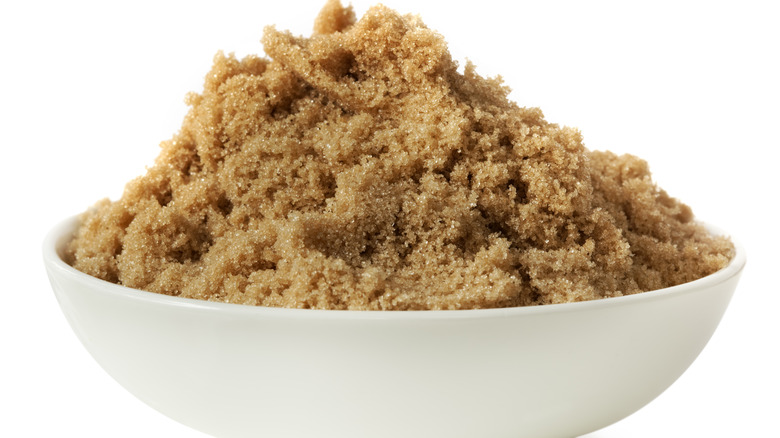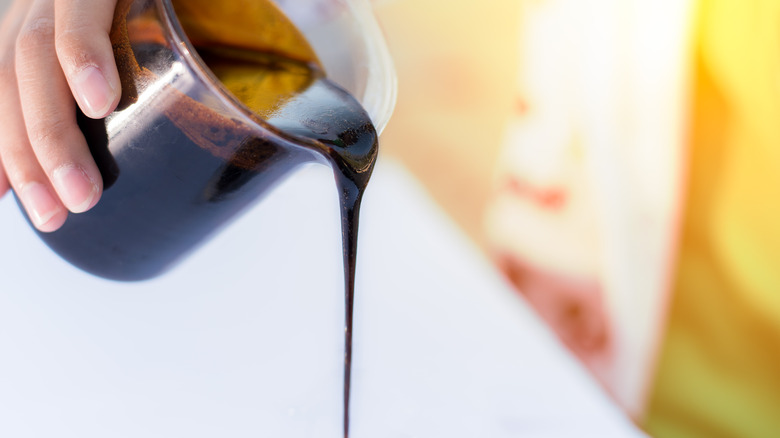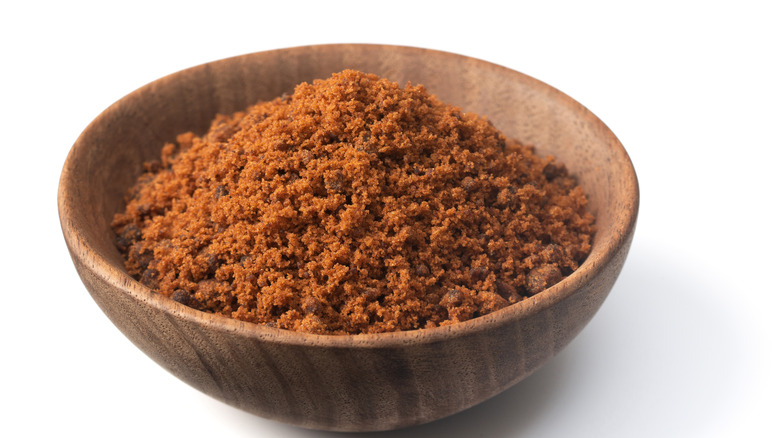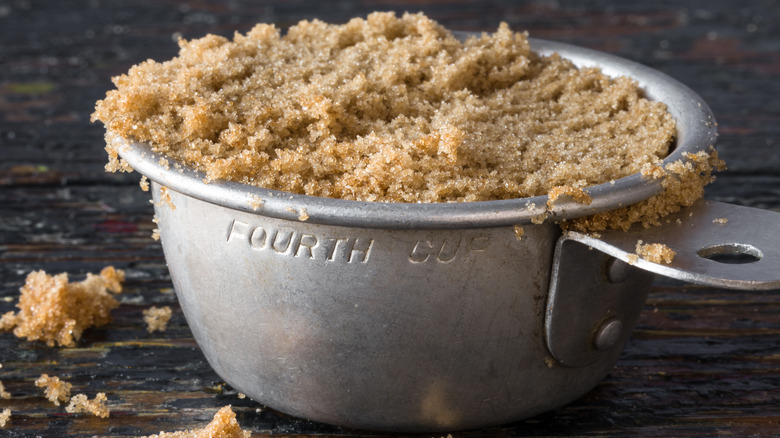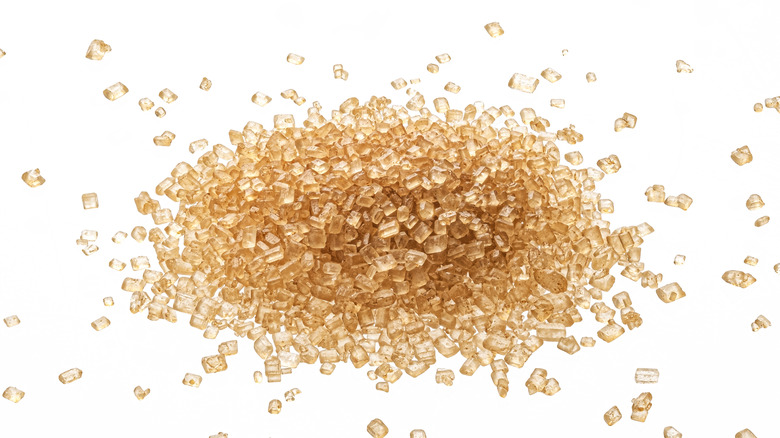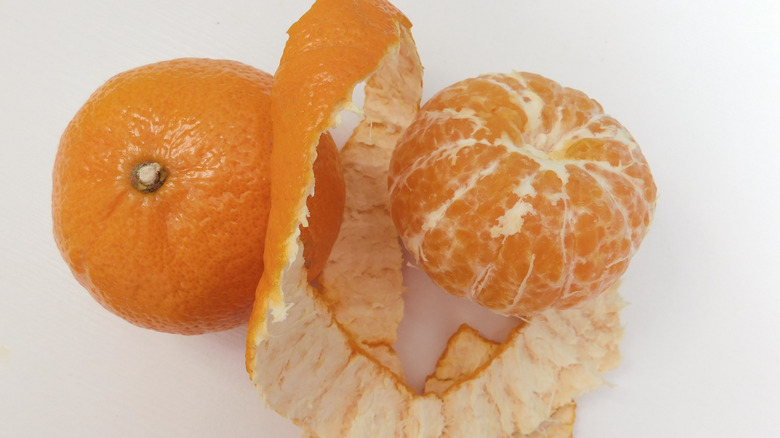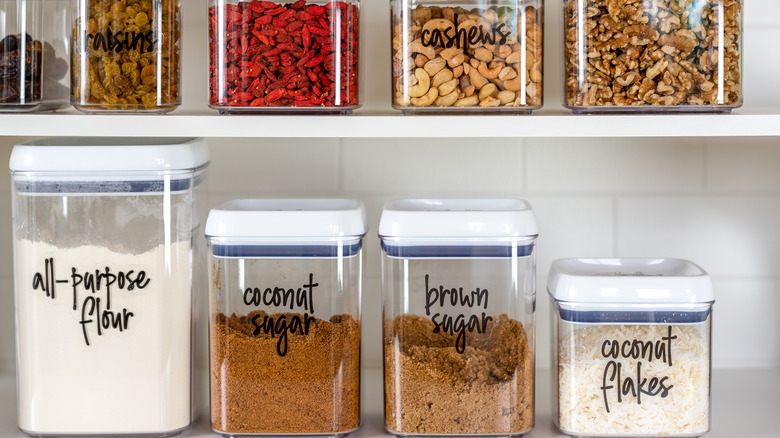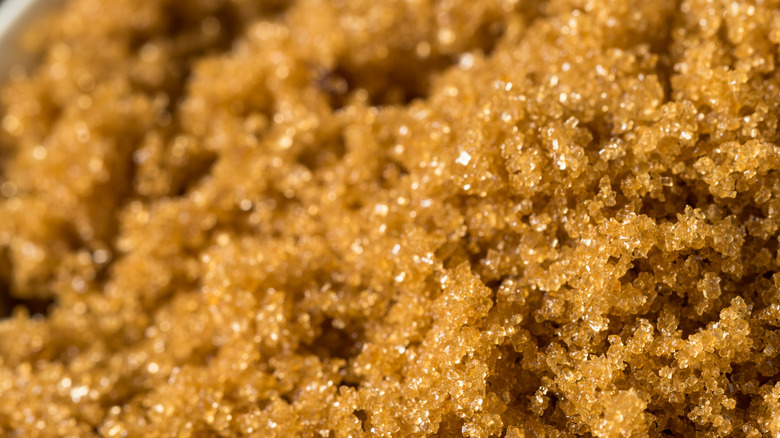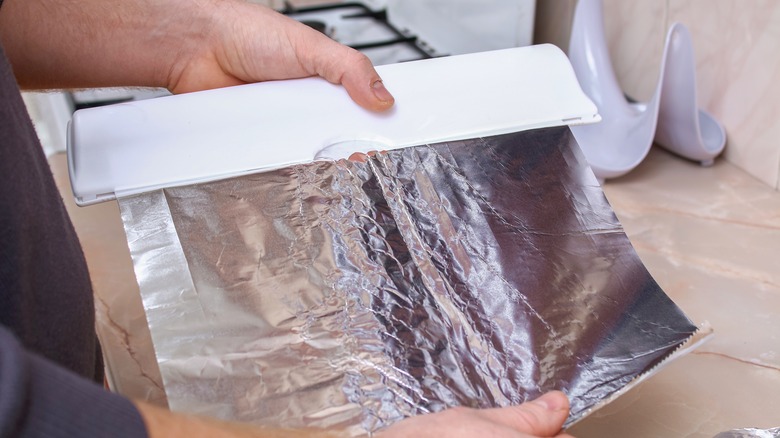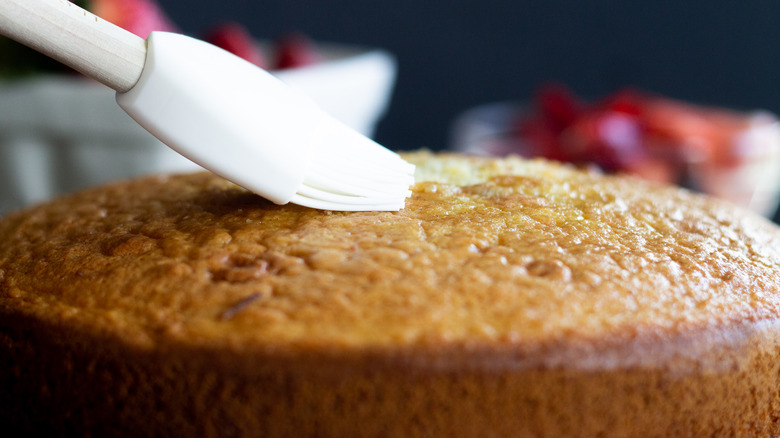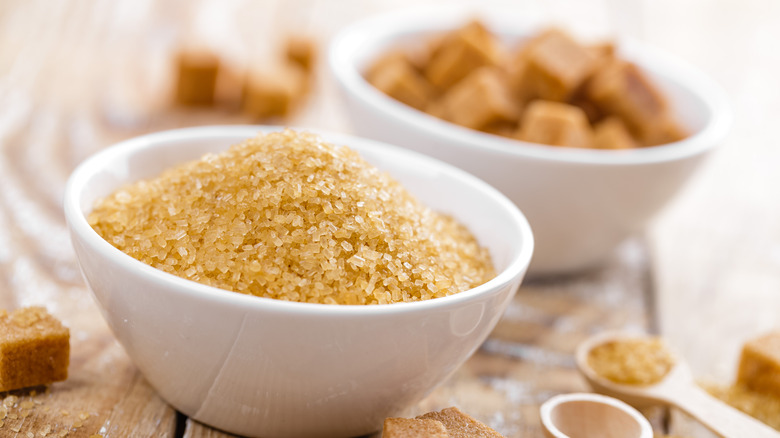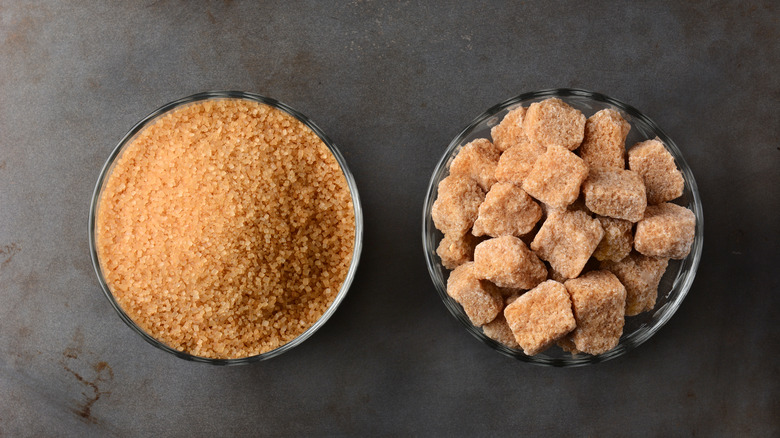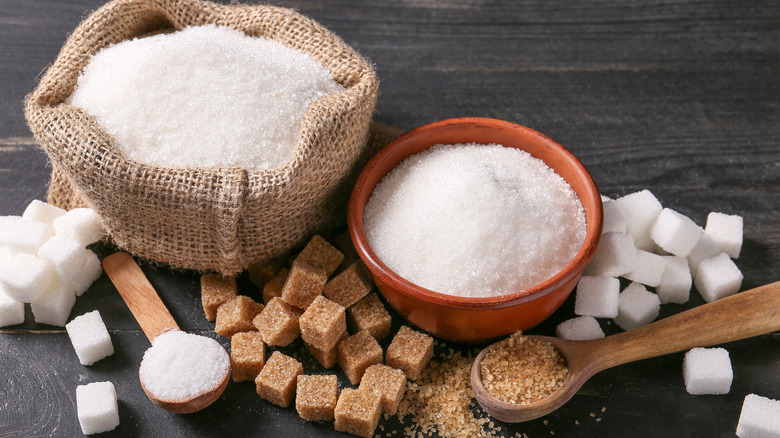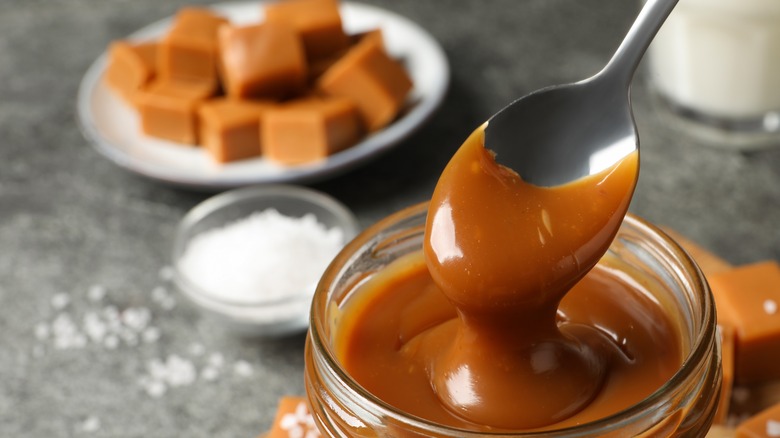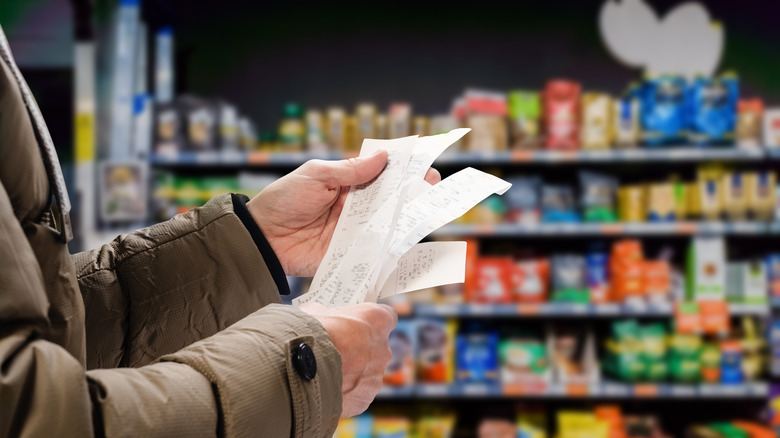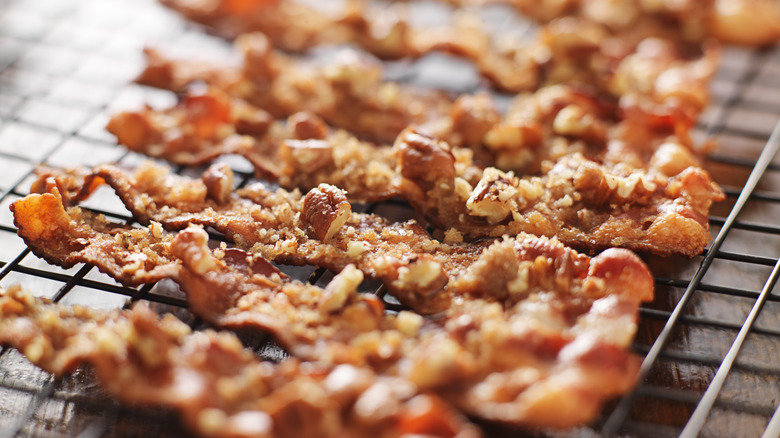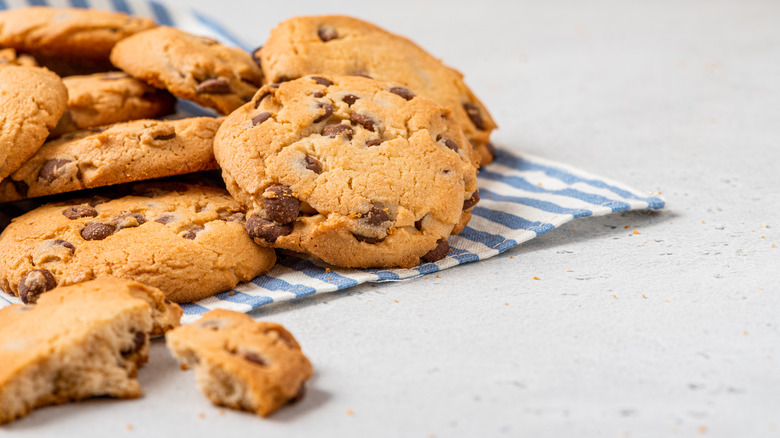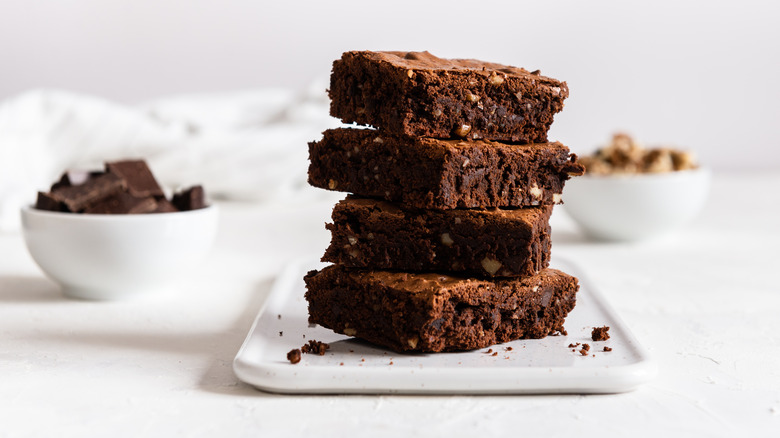17 Tips You Need When Baking With Brown Sugar
Brown sugar is a critical ingredient all bakers should have in their pantries. According to Food Insight, there are two primary ways that brown sugar is produced. The first is that white sugar granules are coated with molasses. Or, molasses crystals are boiled with sugar crystals. The molasses is a byproduct of manufacturing sugar cane; this brown syrup gives the brown sugar its unique color and nutty flavor. The two major types of brown sugar include light brown sugar, which is made with 3.5% molasses, and dark brown sugar, which is made with about 6.5% molasses.
Brown sugar can be found in many different sweet recipes including cookies, cakes, and bread because of its flavor and unique qualities. If you consider yourself a baking novice, you'll need to learn about all of your ingredients, including brown sugar, to ensure you get the optimal utility from each piece of the baking puzzle. Here are some of the most important things you need to know about working with brown sugar.
You can make it at home
Everyone has had moments where they've gotten all the ingredients out and are ready to go ahead and start working. A second check of the recipe reveals that you have forgotten one very important ingredient! While many ingredients require you to purchase the "real thing" from the grocery store, brown sugar is an ingredient you can make at home. You'll need one cup of granulated white sugar for each tablespoon of molasses. To make dark brown sugar, you should use two tablespoons of molasses for each cup of sugar. Stir the two together with a fork until well-mixed. If you only have light brown sugar but need to make dark brown sugar, you can mix in an extra tablespoon of molasses.
We recommend using this homemade concoction when you need it rather than making it in advance and storing it. And since homemade brown sugar only requires two ingredients, you won't spend too much time crafting your quick substitution.
Brown sugar has more moisture than other types of sugar
If you've ever run your fingers through brown sugar versus granulated sugar, you'll notice how much stickier brown sugar is. Per What Sugar, brown sugar has between 3% and 5% moisture, and Granulated white sugar only has about 0.03% moisture. If you replace granulated sugar with brown sugar in a recipe, you'll find that the baked good is much chewier and not as crisp.
If you are substituting brown sugar for a drier type of sugar, can you replicate the same moisture? According to Healthline, if you're looking for a high-moisture substitute for brown sugar, you should turn to liquid sweeteners like honey, maple syrup, or agave nectar. You can replace each cup of brown sugar with ⅔ cup of liquid sweetener. This will account for the comparatively higher moisture of the liquid sweetener and the sweeter taste of honey or maple syrup.
Assume all recipe measurements are for packed brown sugar
If you're working through a cookie recipe, you may see that the recipe calls for one cup of brown sugar. Does this mean loose, meaning that you scoop a cup of brown sugar out of the bag? Or does this mean packing the brown sugar in the cup?
You should always assume that recipes calling for a certain amount of brown sugar is a packed measurement, not a loose measurement. To effectively pack your brown sugar, you should use the back of the spoon to press the sugar into the cup. Once the sugar is in the cup, you should use the back of a knife to level off the measurement. Packing will eliminate the air from the measurement, which makes the measurement more accurate. The other alternative (which won't dirty an unnecessary spoon) is to use a kitchen scale. One cup of packed brown sugar weighs about 200 grams (via Crazy for Crust).
Dark brown sugar and light brown sugar have different impacts on the chemistry and flavor of a baked good
There are important differences between light and dark brown sugar that will alter the texture and taste of your finished baked good. Dark brown sugar has comparatively more molasses than light brown sugar, and this gives the dark brown sugar a more acidic taste and more moisture. If you use dark brown sugar in your recipe, you may have a better rise (since the moisture and acid can interact with the leavening agents) than if you use light brown sugar (via Imperial Sugar).
If a recipe calls for "brown sugar" on a recipe, it likely is calling for light brown sugar. If you use this type of sugar, you'll get the subtle moisture of the light brown sugar without a strong toffee undertone of dark brown sugar. If you want a more pronounced flavor, you can substitute dark brown sugar for light brown sugar using a 1-to-1 ratio.
You can use a citrus peel to soften brown sugar
The high moisture of brown sugar makes it both a blessing and a curse. While it can lead to soft, plush cookies — poor storage of the ingredient can lead to dry, coarse crystals that are stuck together and hard to use.
There are a lot of hacks for ensuring that your brown sugar stays moist. One of the easiest ways to soften hard brown sugar is to add citrus peels to the brown sugar. You can use peels from a lemon or an orange (via Simply Healthy Family). The oils from the peel helps soften the brown sugar in just a few hours. In preparing your peel, you'll want to be sure there is no pulp on the peel of the fruit. Washing and drying the peel well will ensure you're not adding additional moisture to the brown sugar and making the problem worse.
Store brown sugar in an airtight container
The only way to get brown sugar back to its soft state is to ensure that the brown sugar is stored correctly in the first place. You should always store brown sugar in an airtight container to help keep brown sugar soft. Domino Sugar recommends storing brown sugar in an airtight container in a cool, moist space with an airtight lid. For many pantry ingredients, cool and moist spaces are conducive to mold growth. But with brown sugar, this locale is perfect. A pantry is a better storage option than your refrigerator because the refrigerator tends to be in a drier location with dramatic temperature changes.
Domino Sugar notes that you can store your brown sugar in the freezer. You can use a fork to break up the clumps of sugar as it thaws. If you plan to keep the brown sugar in the freezer for a long time, the outlet recommends breaking up the brown sugar to prevent pockets of moisture from forming.
Brown sugar doesn't spoil
In a world where almost everything is perishable, brown sugar is an exception. According to Does It Go Bad, brown sugar itself doesn't support microbial growth. As long as you keep your product away from moisture, it should retain its texture indefinitely. But, the outlet recommends using brown sugar within two years of purchase for optimal flavor. Brown sugar is still good even when it's hard — you just may have to put in more work to help the sugar soften.
There are some occasions when you should throw out your brown sugar. If you notice bugs or insects, obvious mold, or an odd smell, Does It Go Bad recommends throwing it away. If any moisture gets into the sugar, you'll notice pieces of brown sugar that are darker in color than other parts. You should also be aware that the brown sugar left outside of an airtight container tends to absorb the smells of the surrounding pantry.
You can use aluminum foil to soften brown sugar crystals
If you have aluminum foil in your kitchen, you can use it to help soften brown sugar (via Reader's Digest). Simply break off a piece of the brown sugar that you need to soften, wrap it in aluminum foil, and bake it at 300 F for about five minutes. Domino Sugar recommends baking the brown sugar at a slightly lower temperature — at around 250 F. The science of this hack is simple. The heat from the oven causes whatever moisture is left in the brown sugar to seep out. The aluminum foil, which is wrapped around the piece of brown sugar, will retain the moisture and cause the brown sugar to soften again. Trying this trick in the microwave wouldn't work because the microwave would help soften the sugar temporarily but would not produce the long-term softness that you need.
You can make brown sugar syrup out of brown sugar
Simple syrup is a common ingredient for cocktails and coffee because there aren't any leftover sugar granules. The only difference between simple syrup and brown sugar syrup is the type of syrup used. If you want to make brown sugar syrup, you can add equal part water and brown sugar syrup together over heat. Brown sugar syrup has a much deeper flavor than plain sugar syrup, and you'll get the same warm toffee notes of granulated brown sugar. You can also infuse your syrup with ingredients like cinnamon sticks, extracts, and more.
If you want a stronger brown sugar syrup, you can use two parts of sugar for each part of the water. To make your syrup at home, add water and sugar together over heat, constantly stirring until the two are combined. You can use your syrup to brush onto your cakes for a stronger flavor and decadently soft sponge.
There are numerous substitutes for brown sugar
If you don't have brown sugar or molasses, make a brown sugar substitute, you're going to have to turn to another alternative. You should not use straight molasses as a replacement for brown sugar because it can impart a bitter flavor to your baked goods. Plain white granulated sugar won't give you any toffee-like flavors, but it will provide sweetness for stir-fry sauces, homemade barbecue sauces, and savory applications. If you want to replicate the same moisture as brown sugar, you can add a splash of liquid sugar, like honey or maple syrup, or a tablespoon of dark corn syrup.
Liquid substitutes are not always ideal replacements for granulated sugar in baking. If you use honey, you'll need to decrease the other liquid ingredients by ¼ cup for each cup of honey you use (via Big Island Bees). You'll also need ¼ teaspoon of baking soda to reduce the acidity and reduce the oven temperature by 25 degrees.
Using turbinado sugar as a substitute will cause your baked goods to be more crumbly
Turbinado sugar is often mistaken as brown sugar. It is a classification of brown sugar (so this rumor is partially true); turbinado sugar is made with partially-processed sugar that contains a bit of molasses already. Turbinado sugar has a much milder molasses flavor since no additional molasses is added. Since there are less molasses, there will also be a lighter color than traditional brown sugar (via Spiceography). Muscovado sugar has a more moist texture and stronger molasses flavor because it is less processed than turbinado sugar (via the Pritkin Recovery Center).
If you want to replicate the same flavor as dark brown sugar, you should stick to muscovado sugar. If you use turbinado sugar as a replacement for brown sugar, your baked foods will crumble rather than stick together. If you mix it into the batter, you risk leaving residual graininess. Turbinado sugar is overall a better replacement for granulated white sugar — it just has slightly more flavor.
There's minimal nutritional difference between brown and white sugar
Brown bread is healthier than white bread, and whole wheat pasta is more nutritious than white pasta. But are there nutritional differences between brown sugar and white sugar?
Since brown and white sugar contain the same chemical (sucrose), they have similar impacts on the body. According to research from the USDA, brown sugar contains slightly more minerals like calcium, potassium, magnesium, and iron. But, the concentration of these minerals is so minimal in comparison to the recommended daily intake of these minerals. In other words, if you want to ensure you hit your recommended daily intake of potassium, eat a banana.
Brown sugar still contributes to your recommended daily maximum of added sugar. According to the Centers for Disease Control, you shouldn't consume more than 12 tablespoons of sugar each day. Therefore, substituting brown sugar for white sugar isn't doing anything to your diet.
Brown sugar doesn't caramelize as well as white sugar
Numerous chemical differences between brown sugar and white sugar don't make the two interchangeable when it comes to caramelizing. Brown sugar contains impurities that make caramelization more difficult than if you used white sugar (via El Meson Sante Fe). These impurities can also produce bitter flavors if the caramel is overheated. If you try to make a caramel out of brown sugar, you won't get the same flavor as white sugar either. You will get a darker, caramel-like color if you use brown sugar rather than white sugar.
We think trying to make caramel sauce with brown sugar is worth the wait. You can use brown sugar caramel for a drizzle on monkey bread, cinnamon rolls, brownies, or ice cream. El Meson Sante Fe recommends adding some warm spices to your brown sugar caramel for more flavor, as well as a little bit of dark roast instant coffee.
Brown sugar may be more expensive than white sugar
We're all about keeping things affordable — so you may hate when we tell you this. But, brown sugar may be more expensive than white sugar. Unrefined brown sugar, like turbinado and muscovado, can cost up to 12 times more than refined sugar. This price is often dependent on the region where the brown sugar originates (via What Sugar Blog).
Unrefined sugar has the molasses added back into it, compared to unrefined raw sugars that contain trace amounts of molasses left in the sugar. What Sugar Blog notes that since raw brown sugar is not processed with bone char like refined brown sugar (which goes through the same refining process as white sugar), it is suited for a variety of diets, including vegetarianism, veganism, and Kosher diets. If you want to purchase bone-char-free brown sugar, you can use buy organic brown sugar or raw brown sugar (via Plant Prosperous).
You can use brown sugar for savory food too
A lot of people think about brown sugar as an exclusively sweet ingredient. But its caramel flavor and toffee-like appeal make brown sugar a good ingredient for savory food too. You can use brown sugar for pickling everything from cucumbers to eggs. The brown sugar provides a contrast to the acid and the saltiness of the brine — along with more complex flavors than granulated sugar alone. We also recommend adding brown sugar to your favorite stir-fry sauce; it can help subdue some of the heat from your hot ingredients.
Brown sugar is the perfect ingredient for glazing both savory and sweet foods. We love glazing roasted carrots with a quick mixture of butter and brown sugar. The sweetness from the sugar helps bring out the natural sweetness of the carrots. You can also use brown sugar to glaze salmon, pork chops, or our personal favorite — bacon.
Use brown sugar for chocolate chip cookies
If you want to make the perfect chocolate chip cookie, you'll need two things: quality chocolate chips and brown sugar. Since brown sugar has a high moisture content, it can help keep your cookies soft, plush, and dense rather than crisp and snappy. Brown sugar is better than white sugar for making chocolate chip cookies alone because it has a more complex flavor profile to the cookies than using boring white sugar. If you don't like the sweetness of brown sugar, Bobby Flay, in an episode of his podcast "Always Hungry," recommends using some sorghum instead. Sorghum syrup, made from the sorghum grain, has a woody and smoky flavor with a texture similar to that of thin corn syrup (via Green Door Gourmet).
If you want to get the most molasses flavor from your cookie, we recommend using a higher proportion of brown sugar to white sugar. You can play around with the ratios in your chocolate chip (or chunk) cookie recipe to find what flavor you like best.
Brown sugar and brownies are a match made in heaven
Another recipe that benefits tremendously from the addition of brown sugar is brownies. You should use dark brown sugar for these sweet treats because it will produce a chewier, softer brownie with a more complex flavor than white sugar alone. In a pinch, you can use light brown sugar for a brownie recipe, but the flavor shines much brighter if you use dark brown sugar instead. Once the brownies are baked, you'll find that the flavor of the molasses becomes caramel-like and can amplify the other chocolate flavors in your brownies.
Besides adding brown sugar to your brownies, you should also enhance any brownie mix by adding chocolate chips or chopped nuts for texture. You may find that adding mascarpone cheese to your brownies helps boost the moisture content and keeps your brownies firm, fudgy — and all the more decadent.
